Western Digital Red Review: Are NAS-optimized HDDs Worth the Premium?
by Ganesh T S on August 17, 2012 4:20 PM EST- Posted in
- Storage
- NAS
- Western Digital
Stress Testing and Effects of Prolonged Usage
Readers of our other NAS reviews might be aware that we are in the process of building a NAS testbed capable of testing mult-client scenarios. While the details of the testbed will come in a separate piece next week, we will describe the relevant part of the system in this section. Since the Synology DS211+ performed the best amongst the three tested NAS systems and is also officially recommended by WD, we chose it for stress testing. The DS211+ was configured with 2 x 3TB WD Red drives in RAID-1 and connected to a Zyxel GS2200 switch. A dual Xeon workstation was set up to run 12 Windows 7 VMs (each with a dedicated physical disk and a dedicated GbE port connected to the switch). Scripts were set up to do a synchronized data copy from each VM to a Samba share on the DS211+. We paused the scripts after the NAS became 30%, 60% and 90% full to repeat our benchmarks from the previous section. Each 30% step took approximately 15 - 20 hours. A screenshot of the status of the Samba share after the process was completed (90% full) is shown below.
At 90% full, the NAS had more than 7 million files in almost a million folders. 95% of the files were between 0 and 512 KB in size. 1.8% were between 0.5 and 1 MB, 2.8% between 1 and 10 MB, 0.2% between 10 and 100 MB, 0.03% between 100 and 1024 MB, and 360 files were more than 1 GB in size.
The results of running the NASPT / robocopy benchmarks at each stage are provided in the graph below. Note that the NASPT tests were run from one of the VMs in the new testbed, and some of the results could be slightly different from what was obtained with our Summer 2012 NAS testbed.
The above benchmarks show that the performance does degrade (particularly for write intensive benchmarks) as the NAS fills up. However, the big gap that we saw in the raw drive performance (in the HD Tune Pro benchmarks) doesn't seem to be as evident when the disk is being used inside a NAS. In any case, it is always advisable to run any NAS below 90% of the capacity.



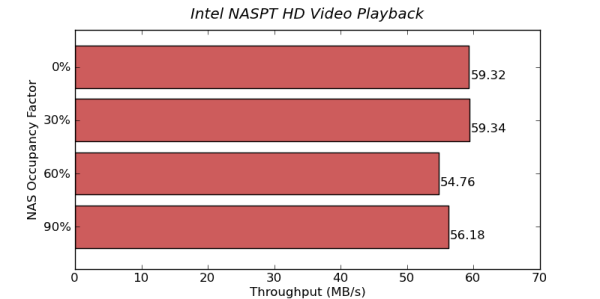
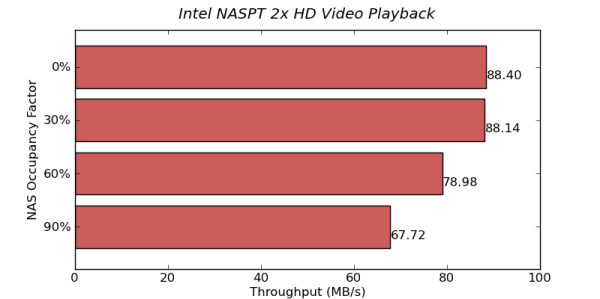
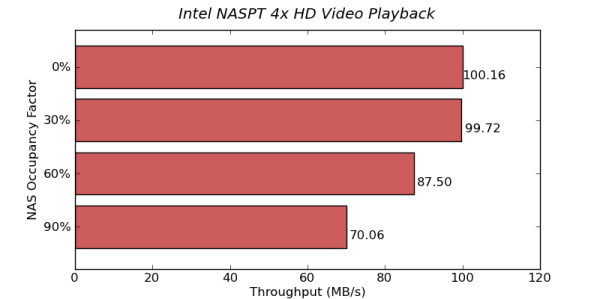
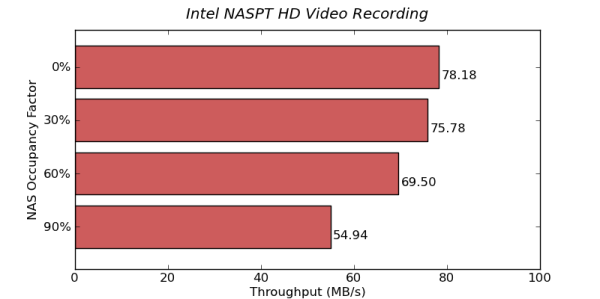
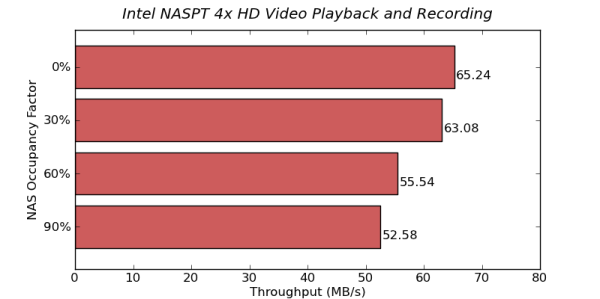
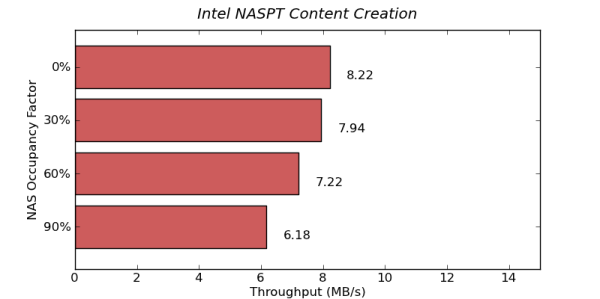
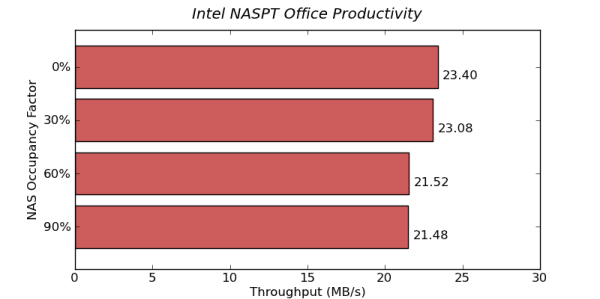
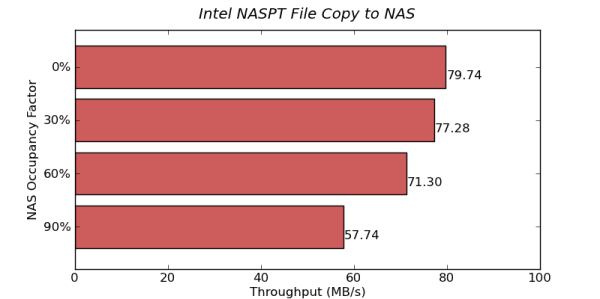
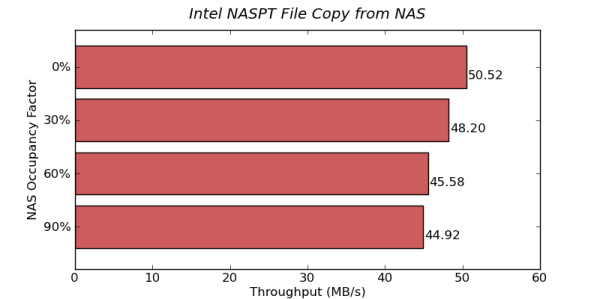
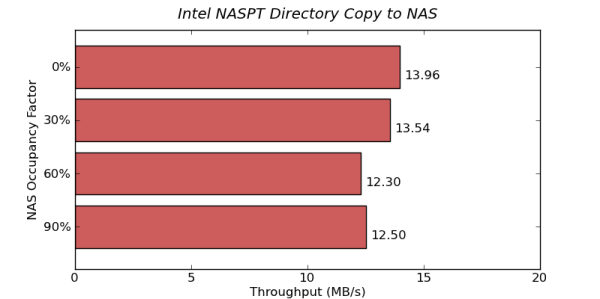
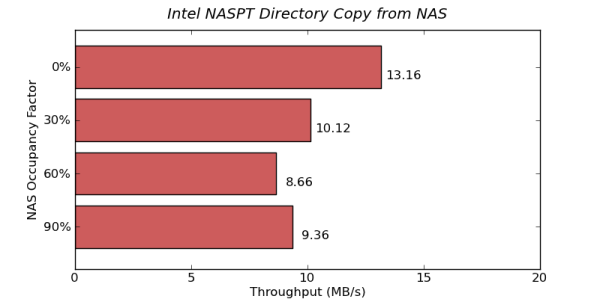
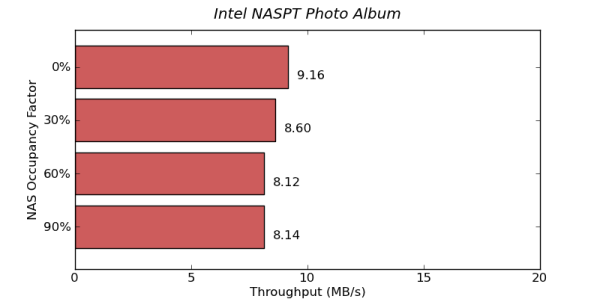
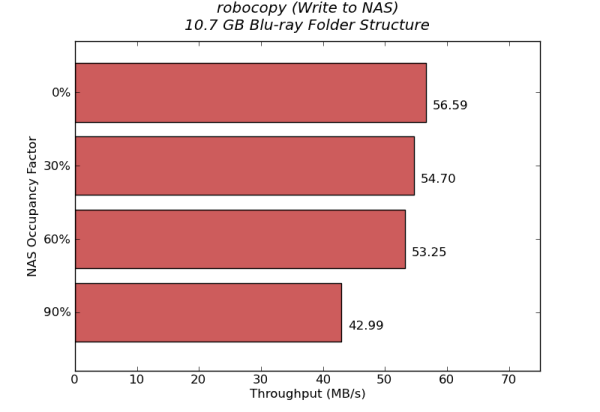
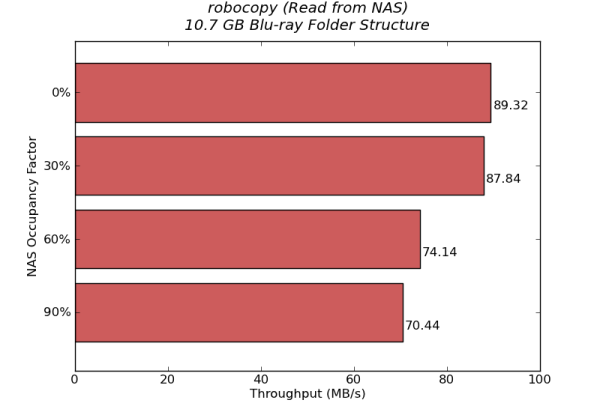








87 Comments
View All Comments
Dzban - Saturday, August 18, 2012 - link
1. Any good recent 7200 RPM drive2.same
3.same but you could use "green" type drive if you would store
not frequentlyu used files like media
vgray35@hotmail.com - Saturday, August 18, 2012 - link
The term "not frequently used drive" reveals nothing about usage. A single usage event could last for 30 minutes. Doing this once a day qualifies as not frequently used. However during that single event power dissipation could cause temperature to rise very high, and this extreme thermal cycling dramatically reduces hard drive life cycle. The low power drive causes peak temperature to be high due to inadequate cooling due to the drive's physical construction in part. So what does "low power and not so frequently used drive" really mean. Typically it means low quality, low reliability and dubious low power capability.Just focus on good quality drives from the start in all situations and spend the money to make life more simple. GREEN OR BLUE drives are just not worthwhile for any application. Open one up and take a look. BLACK is better so use it everywhere. RED appears to be better yet, so maybe we should use that one in every situation instead.
ECO drives are not worthwhile.
probedb - Monday, August 20, 2012 - link
Odd, I had a Blue running as the OS drive in a server for 2-3 years without failure before I replaced with with an SSD.Open one up? What would that tell us exactly?
vgray35@hotmail.com - Monday, August 20, 2012 - link
Yip it happens - depends on temps and temp cycling. Proves nothing, except that you likely did not drive them particular hard. One guy got 3y with a GREEN in a server.I ran two Blues in a laptop and these only lasted approximately a year each. All depends on what these drives are being subject to on the one hand, and how well they can take on the other hand.
I monitor drive temps all the time - like watching the fuel gauge on my car - and I know at all times how hard they are being driven. I make sure they always have the best possible environment to operate in because they will be driven hard. I have far less trouble with BLACK drives.
vgray35@hotmail.com - Monday, September 3, 2012 - link
A Blue drive for an OS drive in a server with low temp cycling will last that long. The thermal environment is what makes it last. The drive is not however designed for temp exceeding 45C with extremes of thermal cycling.Good drives consider elements such as: Stiffness of components; thickness of magnetic coating on the discs; cooling design, electronic design, firmware. To the trained eye you will see a big difference in design between say a BLUE drive and a BLACK drive.
_niko_ - Monday, August 20, 2012 - link
According to WD since i mailed them asking a few questions regarding this straight after the pressrelease.Thank you for contacting Western Digital Customer Service and Support. My name is Michael.
The WD Red drive is designed to fit into a particular niche in the market. These drives were designed to be compatible with RAID enclosures of 2-4 bays. The list of tested and supported RAID enclosures are included below.
1. Synology, QNAP, D-Link, Drobo, Netgear, and Thecus.
2. It would be best to contact these enclosure makers for a list of specific models campatible with WD Red drives.
The WD Red drive is built on Green technology, this is not a RE or Enterprise class drive. There is no TLER (Time Limited Error Recovery) enabled on this family of drive. TLER is used only in our RE or Enterprise class drives. These drives are not designed to be used in Enterprise environments.
The drive has four means of error recovery:
1. ECC On-the-Fly
2. Preamp Thermal Asperity (TA) Compensation
3. Read/Write Retry Procedure
4. Extended Read Retry Procedure
The heads do park after 8 seconds using our No Touch Ramp Load Technology.
Parks the recording heads off the disk surface during spin up, spin down and when the drive is off.
This ensures the recording head never touches the disk surface resulting in improved long term
reliability due to less head wear, and improved non-operational shock tolerance.
If you have any further questions, please reply to this email and we will be happy to assist you further.
Sincerely,
Michael
Western Digital Service and Support
http://support.wdc.com
vgray35@hotmail.com - Tuesday, August 21, 2012 - link
And what did you learn from that WD response? Not a whole lot. A RED drive is certified for 1,000,000 load cycles, while GREEN, BLUE, BLACK are significantly less, so how could they possibly be based on the same so called GREEN technology. Pure marketing hype nothing more is what WD sprouted forth.
Ipso facto the RED drive cannot be built on GREEN technology. It just sounds nice. 1,000,000 load cycles is a lot different from what the GREEN drive is capable of, and it certainly has much more to do with hardware technology than just plain firmware tweaks.
The Enterprise RE4 and XE drives are rated at only 60% of the load/unload cycles of the RED drive (600,000 as compared with 1,000,000). RED is not GREEN technology - sorry WD - at least not in terms of what's in the GREEN drive per se, and as much as WD would like us to believe RED is not suited to ENTERPRISE loads, they are simply just lying. Warranties differ 3y as against 5y between RED and Enterprise, and what enterprise drives are paying for is the higher warranty and commitment WD offers (plus slightly better hardware).
I suspect RED would do just fine in an enterprise environment, just need to change them out more often in line with the 3y warranty, and you would still be saving money. I bet that 5y warranty on BLACK is going to be phased out pronto.
These companies think we are stupid, and in reality these drives jockeying for different markets is sprinkled with a lot of marketing effluvia. I would rather listen to the engineers but they are not allowed to speak.
Comparing RED to Enterprise RE4 specs I would take the RED anytime despite the lower 3y warranty, where the latter offers 66% more load/unload cycles, draws much less power, and offers 70C operating temps rather than 55C. Imagine lower power and 15C higher operating temp limit. Looks like a good Enterprise drive to me. What WD really meant by RED drives not being designed for enterprise environment is really this: "You have not payed the premium for 5y warranty therefore we will not support it in that application". Who cares, we intend to forcibly replace them before the warranty is up anyway.
I like these RED drives from what I can see at first blush, and I fully intend to use them in Enterprise environments without asking for WD permission. I am a programmer, so my NAS drive is always operating in an Enterprise environment loading scenario. My servers will be upgraded to RED.
I hope they make 2.5" RED drives so I can replace my BLACK drive with a RED drive in my laptop.
Affectionate-Bed-980 - Monday, August 20, 2012 - link
Comparing a RED drive against any other drive is pointless unless its the WD Green. What you're trying to establish is whether a new "NAS" specific drive has any benefits.The Green drive already represents a 5400 rpm storage drive that's popular in NAS applications. YOu could compare against other drives such as the Seagate or Hitachi or Samsung green drives, but differences could be attributed to how good the drive is to begin with. A WD Green drive is the correct benchmark.
What the hell did I learn when you benched against a 7200rpm Seagate Barracuda? NOTHING. You could've benched a WD Green against a 7200rpm Seagate or Samsung 2TB against a 7200 rpm drive.
I realize HD reviews aren't AT's specialty, but if you read StorageReview's WD Red review, at least it makes sense. You need to be making logical comparisons.
I'm sure people look for BMW 335 reviews are also comparing it heads up against a Prius. Ugh.
Affectionate-Bed-980 - Monday, August 20, 2012 - link
better yet you could've compared Red vs Green vs Blue vs Black.andersenep - Tuesday, August 21, 2012 - link
I've been using the WD green drives in my file server for over 4 years now. Initially, I did not know to disable the intellipark feature with the wdidle utility, and racked up some ridiculous load cycle counts (about 150k) on my first four 1TB drives. Despite this, the drives lasted over 2 years before I replaced them with 2TB drives for more space; not because the drives had problems. I still use those same drives in a RAID 10 two more years later on my desktop.I really don't see any reason to spend $50-80 more a drive for a "feature" I can enable/disable myself. I've read so much negative stuff on using WD green drives in RAID/NAS, but I haven't had any issues personally.
Seriously, $50 (2TB) to $80 (3TB) more per drive for what?? No thanks. I'll take the cheapest, low power drives and regular backups any day. Hasn't done me wrong yet. I also have a bunch of Samsung green drives that have performed just as admirably as the WDs for even cheaper (on sale).